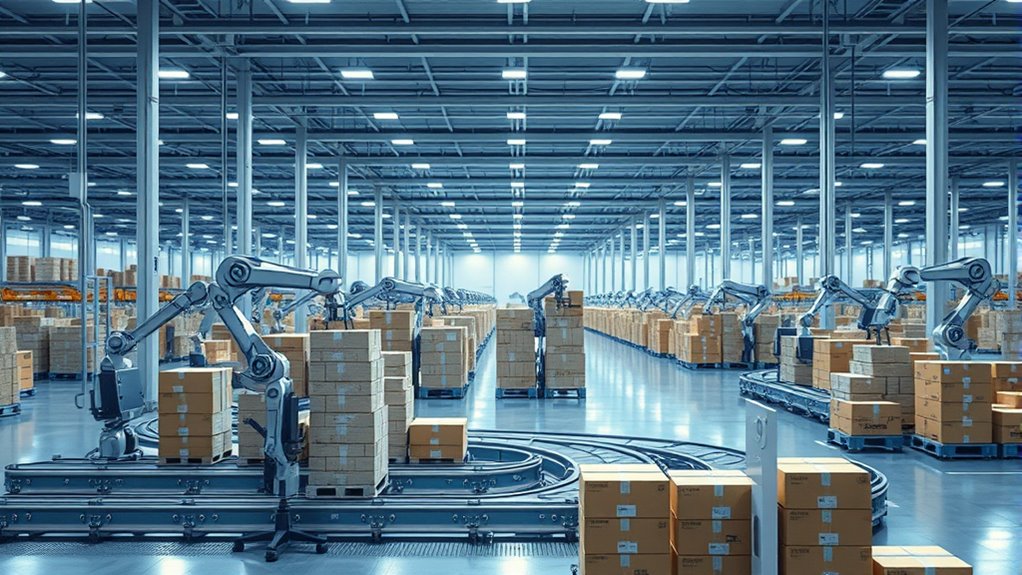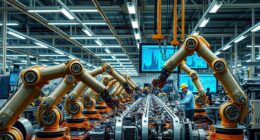Many jobs once thought safe have already disappeared due to automation. Quality inspectors are replaced by AI vision systems that catch defects faster and more accurately. Warehouse roles are now handled by robots and autonomous vehicles that pack, transport, and manage inventory. Data entry clerks face obsolescence as AI software achieves near-perfect accuracy. Customer service jobs are transformed by chatbots, and office assistants are supplanted by AI tools that manage scheduling and content creation. To discover more about these changes, keep exploring.
Key Takeaways
- Human inspectors in quality control have been largely replaced by AI-powered vision systems with higher accuracy.
- Data entry clerks are increasingly obsolete due to AI software achieving near-perfect accuracy.
- Routine customer service roles are disappearing as chatbots automate up to 70% of inquiries.
- Warehouse packing and inventory management jobs are declining as robots and autonomous vehicles take over these tasks.
- Traditional administrative assistants are being phased out due to automation of scheduling, document handling, and content creation.
Quality Inspectors Vanished Thanks to Vision Systems

Thanks to advancements in machine vision technology, quality inspectors are rapidly disappearing from production lines. These AI-powered systems use cameras and algorithms to inspect products with high precision and in real time, catching defects immediately. They’re faster and more consistent than human inspectors, who often miss flaws due to fatigue or variability—up to 40% in some cases. Machine vision integrates with IoT and cloud analytics, enabling predictive maintenance and data-driven decisions that humans can’t match. This shift reduces labor costs and error rates, ensuring higher product quality across industries. While humans still have an edge in interpreting complex visual data, AI’s rapid progress is narrowing this gap. As a result, many companies are downsizing manual inspection teams or retraining staff for system oversight. High-resolution imaging allows detailed inspection of products that would be difficult for the human eye to detect. Additionally, the use of automated safety features in inspection systems further enhances reliability by minimizing potential errors.
Warehouse Roles Replaced by Robots and Automation

Robots and automation now handle many warehouse tasks, from packing to inventory management. Automated packing systems speed up operations, while AI-guided tools keep stock levels accurate in real-time. Self-driving warehouse vehicles move goods efficiently, reducing the need for human operators. Automation’s support helps address the ongoing labor shortages faced by the industry, ensuring smoother operations. Additionally, wall organization solutions can optimize storage spaces, making automation even more effective and enhancing overall warehouse efficiency.
Automated Packing Systems
As automation continues to advance, warehouse packing roles are increasingly being replaced by robotic systems that enhance speed and accuracy. Automated packing systems, including robotic arms and conveyor integrations, streamline the process, reducing the need for manual labor. By 2025, thousands of warehouses will deploy these systems to handle high-volume packing tasks efficiently. These systems minimize errors, increase throughput, and lower operational costs—up to 60% in labor savings. As a result, traditional packing jobs are disappearing, replaced by roles focused on managing and maintaining these automated solutions. The rise of robotic packing reflects broader industry trends driven by labor shortages and the demand for faster, more reliable order fulfillment. You’ll find fewer manual packers, but more technicians overseeing sophisticated automation. Financial considerations such as cost savings and investment in new technology play a crucial role in this transition.
AI-Guided Inventory Management
AI-guided inventory management is transforming warehouse operations by automating stock control and enhancing workflows. You rely on AI algorithms that analyze historical data and market trends to forecast demand, reducing inventory discrepancies by up to 35%. These systems detect out-of-stock items and alert managers, maintaining ideal stock levels. They also determine the most efficient storage and retrieval paths, boosting productivity. Robotic systems and AI analytics lower manual errors and operational costs, making processes more agile. Here’s a snapshot of key technologies:
| Technology | Function | Impact |
|---|---|---|
| AI demand forecasting | Predicts inventory needs | Reduces stockouts and overstocking |
| AI detection systems | Monitors stock levels | Maintains optimal inventory |
| Optimized routing algorithms | Guides product movement | Enhances workflow efficiency |
Self-Driving Warehouse Vehicles
Autonomous mobile robots (AMRs) and automated guided vehicles (AGVs) are transforming warehouse logistics by taking over transportation tasks traditionally performed by human workers. These vehicles navigate warehouses independently, using advanced sensors and navigation technology to operate efficiently in dynamic environments. They markedly boost productivity, cut labor costs, and reduce errors by optimizing routes and managing real-time data. Large retailers are leading the adoption, utilizing these robots to streamline operations and improve accuracy. As a result, roles like vehicle operators and material handlers are disappearing, replaced by smarter, automated systems. With ongoing technological advancements, self-driving warehouse vehicles are reshaping how goods move within facilities, making manual transportation tasks increasingly obsolete and paving the way for fully automated warehouse environments. Additionally, the integration of high-precision sensors further enhances their ability to operate safely alongside human workers and other equipment.
Data Entry Clerks Outpaced by AI Software

Data entry clerks find themselves increasingly outpaced by AI software that delivers higher accuracy and faster processing. AI systems now achieve accuracy rates of 99% to 99.99%, far surpassing human accuracy, which ranges from 85% to 99%. With about 7.5 million data entry jobs at risk, 94% of tasks are highly automatable, and automation has cut manual work by 80%. Industries like finance, healthcare, manufacturing, and retail are adopting AI to handle large volumes of data efficiently, saving companies hundreds of thousands annually. As automation becomes more prevalent, employment for data entry clerks declines, especially in sectors with repetitive tasks. This shift demands workers adapt or face obsolescence, illustrating how AI is transforming this once-stable job market.
Customer Service Jobs Transformed by Chatbots

Chatbots are transforming customer service by handling routine inquiries quickly and efficiently, freeing up human agents for more complex issues. With AI-driven support, companies see faster response times and reduced operational costs. As this technology advances, you’ll notice a shift in how customer interactions are managed and delivered. Moreover, they can collect customer data and feedback via machine learning, enabling personalization and continuous service improvement. Additionally, automation‑proof jobs are increasingly disappearing from traditional customer service roles as AI takes over repetitive tasks.
Automated Support Efficiency Gains
As customer service transforms through automation, businesses are increasingly leveraging AI to boost efficiency and responsiveness. Up to 70% of customer requests can now be automated with advanced AI tools, leading to faster response times—improving by up to 30%. Consumers prefer AI assistants for handling queries, with 67% favoring their use. Investment in AI shows strong returns, with 90% of CX leaders reporting positive ROI. Automation enables 75% of CX leaders to expect 80% of interactions to be resolved without human intervention soon. AI acts as a support co-pilot, enhancing agent performance and providing 24/7, consistent support. These gains reduce costs, increase accuracy, and free human agents for complex issues, driving overall operational efficiency. Market size projected to reach $47.82 billion by 2030, with the integration of automated support systems playing a crucial role in this growth.
Chatbots Handle Routine Tasks
With AI transforming customer service, routine tasks are increasingly handled by chatbots, allowing human agents to focus on more complex issues. Over 67% of consumers worldwide have interacted with a chatbot in the past year, and 80% of companies plan or already use AI-powered bots by 2025. These chatbots manage up to 80% of routine inquiries, leading to significant cost savings—like NIB saving $22 million. By 2024, automation is expected to save businesses 2.5 billion hours. Chatbots excel at instant responses and are available 24/7, improving satisfaction for those who prefer quick, bot-assisted support. However, 75% of customers find chatbots struggle with complex issues, highlighting the ongoing need for human intervention. The AI customer service sector is projected to reach $4.1 billion by 2027, underscoring the rapid growth and increasing reliance on automation in support functions.
Manufacturing Jobs Reduced by Intelligent Automation

Intelligent automation has markedly reduced manufacturing jobs, displacing approximately 1.7 million roles worldwide. You’re likely aware of the rise in industrial robots, with 2.5 million now in use globally, boosting efficiency and cutting operating costs by an average of 22%. While many jobs have disappeared, automation also creates new opportunities; in the U.S., automation roles are projected to grow 15% by 2025. Technologies like AI and robotics are transforming production lines, emphasizing highly skilled tasks that machines cannot easily perform. Companies are investing in automation to stay competitive, resulting in significant cost savings and productivity gains. Additionally, the development of advanced filtration systems in manufacturing environments helps improve air quality and worker safety. However, this shift demands that you learn new skills, as the workforce adapts to a landscape where human expertise complements advanced machinery. The industrial automation market is expected to reach $379 billion by 2030, highlighting the scale of ongoing technological transformation.
Office Assistants and Content Creators Supplanted by AI

AI is transforming office support roles by automating routine tasks like scheduling, data entry, and document management, allowing professionals to focus on strategic initiatives. As a result, traditional roles such as administrative assistants, executive secretaries, and payroll clerks are at high risk of disappearing. AI tools like Zendesk AI Suite and IBM Watson now handle customer inquiries, reducing the need for human staff. Many HR professionals are working beyond capacity due to understaffing, accelerating automation adoption. Content creation also shifts; platforms like ChatGPT and Jasper automate routine tasks like SEO copy and product descriptions, while humans focus on oversight and strategy. Recognizing the emotional support needs of individuals affected by these changes can help ease transitions and foster resilience.
Frequently Asked Questions
Are There Any Jobs Completely Immune to Automation?
You’re wondering if any jobs are entirely immune to automation. While some roles, like those requiring high emotional intelligence, creativity, or manual skills, are less likely to be automated, nothing is entirely immune. As technology advances, even the most resistant jobs might evolve or be supplemented by automation. However, roles centered on human connection, empathy, and complex decision-making currently have the best chance of remaining largely human.
How Quickly Do Automation Trends Typically Replace Jobs?
You want to know how fast automation replaces jobs. Automation trends are happening rapidly, often displacing roles within months rather than years. Major companies like Microsoft and IBM have made thousands of AI-related cuts in just a few months, and projections show millions of jobs could be affected globally by 2025. This swift pace means you should prepare for significant changes in the job market sooner than you might expect.
Can Automation Lead to New Job Creation?
Automation can definitely lead to new job creation. For example, by 2025, AI-driven automation is expected to create a net gain of 97 million jobs worldwide, despite displacing millions. You’ll find that sectors like healthcare, logistics, and retail are adding more AI-enabled roles than they lose. This shift means you’ll need to adapt, but it also opens opportunities for growth, innovation, and new career paths in an evolving job market.
What Skills Are Essential for Remaining Employable?
To stay employable, you need to develop critical skills like analytical thinking, resilience, and leadership. Embrace digital fluency, data literacy, and innovation to adapt to changing tech landscapes. Cultivate curiosity, emotional intelligence, and teamwork, which are increasingly valued. Focus on lifelong learning to keep pace with trends. By honing these skills, you’ll remain resilient and competitive in an evolving job market.
Will Automation Eventually Affect High-Skilled Professions?
You might think high-skilled professions are immune, but they’re not entirely off the hook. Automation will change how you work, taking over repetitive tasks and enhancing your decision-making. While AI can’t replace your judgment or interpersonal skills, you’ll need to adapt and learn new tools. It’s a balancing act—embracing technology without losing the human touch—so your profession evolves, but it won’t disappear. Keep your skills sharp, and you’ll stay ahead.
Conclusion
As automation sweeps through every corner, it’s like a tide reshaping the shoreline—washing away old jobs and carving new paths. You’re riding this wave of change, not drowning in it. Embrace the shift, adapt your skills, and find new horizons beyond the horizon of yesterday’s work. The future’s a blank canvas, waiting for you to paint with innovation and resilience. Stay flexible—your next chapter is just beyond the horizon.









